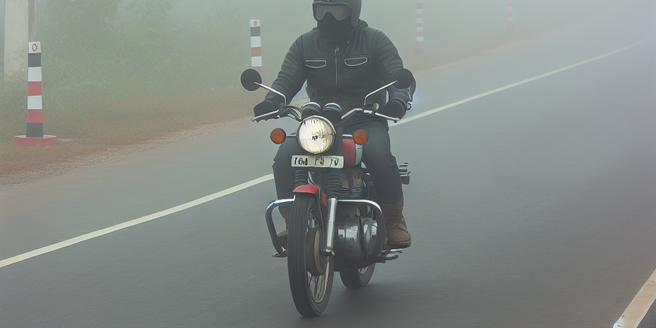
Understanding the Dangers of Fog for Motorcyclists
Fog, an atmospheric phenomenon often underestimated, plays a crucial role in road safety, considerably affecting drivers and motorcyclists. This dense, ground-level cloud obstructs visibility, slowing reaction times and increasing collision risks. Particularly for motorcyclists, fog sticking to helmet visors can create partial blindness, adding another level of danger. Additionally, fog brings moisture that contributes to slippery roads, akin to black ice, enhancing vehicle slippage risks, loss of control, and tailspin probability. Hence, fog’s presence indeed warrants careful attention and appropriate measures to ensure safe, accident-free travel during such conditions.
Choosing the Right Gear for Foggy Conditions
Choosing the right gear is crucial for a foggy ride. Gear designed for such conditions increases visibility and safety. This includes a reliable helmet with an anti-fog visor or special coating to prevent fogging, enhancing your view through dense fog. Visibility is of utmost importance in challenging conditions; a well-designed helmet provides this.
In addition, your gear should include luminous or reflective high-visibility clothing to stand out in low visibility conditions. Subtle color and luminosity variations enhance effectiveness, making you more apparent on the road.
Additionally, a sturdy, bright headlight pierces the dense fog, providing a clear path and improving forward visibility. Furthermore, a high-intensity taillight enhances the visibility of your ride to other road users.
Choosing the best safety gear, being visible to other motorists, and being prepared for most challenging road conditions can significantly improve your safety and overall riding experience. Proper gear selection can make the difference between a safe trip and a dangerous one.
Effective Riding Techniques in Fog
Driving cautiously requires maintaining a safe distance from vehicles ahead, giving you extra time to react to changes on the road, thus enhancing your safety. It’s also essential to improve your visibility by using low-beam headlights, especially in low visibility conditions, which decreases the risk of blinding oncoming drivers and consequently prevents potential accidents. Concentrating on road markings enhances your awareness, enables ease in maintaining direction, and helps in avoiding detours or unintentional dangers. In the case of multi-lane highways, steering clear of fastest lanes often crowded with semi-trucks and their blind spots is recommended, with slower lanes providing more room for smoother, safer navigation. The key to driving safety is adhering to these guidelines which prepare you for unexpected road conditions and actions from fellow drivers.
Tips for Enhancing Visibility during Foggy Rides
Maintaining clean, bright bike lights ensures both your visibility of the road and your visibility to other drivers, reducing accident risks. Regular checks are an important pre-ride routine to confirm the lights’ good condition. Extra lights enhance visibility further, especially when driving in darkness or areas with poor visibility. Reflective tape added to your bike and clothing, and brightly colored garments, especially neon, increase your visibility. Anti-fog spray is a necessary tool to prevent your face shield from fogging up in chilly weather and inhibiting your view. Applying it should be part of your pre-ride ritual. To boost visibility and safety on the road, properly maintain your lights, add extra lights, use reflective tape, wear bright clothes, and don’t forget the anti-fog spray.
Responsible Riding: Avoiding Common Mistakes in Fog
Negotiating your way while riding in dense fog is undoubtedly a challenging task requiring advanced skills and caution to avoid dangerous behaviors such as tailgating or riding at high speeds, as these might lead to accidents. Regular maintenance of your vehicle, particularly paying attention to critical aspects like lights and brakes, can significantly influence your safety in hazardous conditions like fog. Identifying when conditions have worsened too much for safe travel is crucial; it might be necessary to pull over and wait for the fog to lift, avoiding the risks of reduced visibility. Remember, every aspect of safety, from speed reduction, maintaining appropriate distances, to vehicle condition, contributes to your safety. So, ride safely and considerately for both yourself and everyone else on the road.
